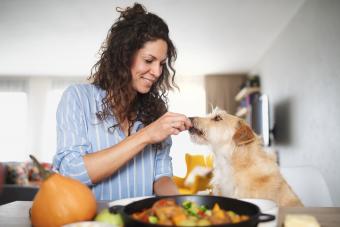
No, dogs should never eat pork rinds. A single dropped pork rind is unlikely to harm your dog if they snap it up before you can intervene, but you should not offer these as a treat. Pork rinds, whether they are called chicharrones, scratchings, cracklings, or pork skin, are not only unhealthy, but could be hazardous to your dog's health.

Pork Rinds Are Not Safe for Dogs
Pork rinds are made from pig's skin. They are deep-fried or cooked in the oven to make them crunchy. A dense fat layer lies beneath the skin. They can sometimes be cooked with the fat intact.

Dogs fed these types of food are also at risk of contracting a dangerous ailment known as pancreatitis. Not to mention, pork rinds would likely contribute to the alarmingly high incidence of obesity among pets.
If you were to plan making your own pork rinds, allowing your dog to eat raw pig skin can be even more harmful. Dogs should not consume raw pork because it can contain a parasite called trichinosis (Trichinella spiralis) larvae if not cooked completely. This might result in a dangerous parasitic infection.
What to Do if Your Dog Ate Pork Rinds
Your dog is unlikely to suffer any consequences as a result of eating a few pork rinds. Some dogs may show signs of stomach upset if the rinds are spicy or contain onion in the ingredients.
The issue arises when dogs consume these snacks on a regular basis. If you've been giving your dog pork rinds as a treat for a long time, they may have accumulated an excessive amount of salt in their diet.
Another scenario that may cause excessive salt intake would be consumption of a large bag of pork rinds in one sitting. Keep in mind that a dog would have to ingest a large amount of salt to be poisoned by it. However, the smaller the dog, the less salt they would have to consume to reach a lethal level.
Symptoms to Watch For
Salty foods pose the risk of salt poisoning. When this happens, the dog must compensate for the excess salt in their system by releasing water from cells. The body's cells are unable to cope with such water loss, and the dog may suffer major health problems as a result. Seizures, kidney problems, severe dehydration, and even the death of the dog's brain cells are all concerns.
The following are symptoms to watch for if your dog has crunched on too many rinds:
- Digestive Upset: Your dog may have stomach pain, vomiting, or diarrhea.
- Physical indications: Physical reactions to these disorders include trouble walking, sensitivity to touch, curling up, or hunching over in an awkward position.
- Additional symptoms: Watch for seizures, tremors, weakness, depression, frequent urination, unquenchable thirst, and high fever.
When to Go to the Vet
It's vital to bring your dog to the veterinarian as soon as possible if they have eaten pork rinds and are experiencing nausea, vomiting, diarrhea, or signs of salt poisoning. If they don't have any major symptoms, keep an eye on their behavior and physical symptoms for the next 24 hours to see if they require veterinary attention.

Dog-Friendly Foods Similar to Pork Rinds
The range of dog products accessible in today's market is one of the advantages of being a modern dog owner. While you eat pig rinds, your dog can enjoy a variety of pork-related dog goodies, including:
Not a Snack You Can Share
Unfortunately, not all human foods are safe for dogs, so you must exercise caution when sharing your treats. Because of the smell, most dogs will be drawn to pig rinds, skins, and cracklings. This isn't a snack you can share. Those puppy eyes are tempting, but regardless of how adorable they look, you should offer something more dog-friendly.







